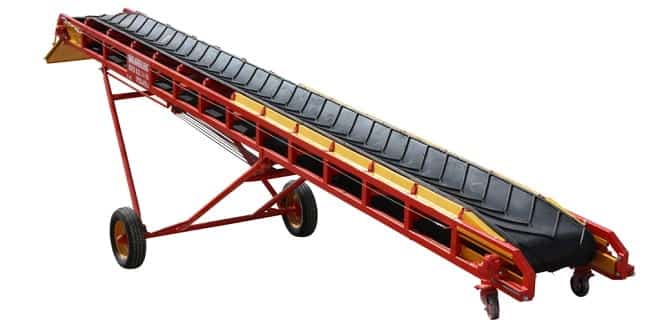A conveyor system is a common piece of mechanical handling equipment that moves materials from one location to another. Conveyors are especially useful in applications involving the transportation of heavy or bulky materials.
Designing a Conveyor System
Capacity requirement
Length of travel
Material characteristics
Processing requirements
Life expectancy
Costs
MAIN ELEMENTS OF A CONVEYOR
Conveyor drive
Conveyor motor
Auxiliary Equipment
Control of Conveyors
Conveyor drives
• Conveyor drives may account for from 10 to 30 percent of the total cost of the conveyor system, depending on specific job requirements. They may be of either fixed-speed or adjustable-speed type.
• Fixed-speed drives are used when the initially chosen conveyor speed does not require change during the course of normal operation. Simple sheave or sprocket changes suffice should minor speed alterations be needed. However, for major adjustments motor or speed-reducer changes are required. In any event, the conveyor must be shut down while the speed change is made.
• Adjustable-speed drivesare designed for changing speed either manually or automatically while the conveyor is in operation, to meet variations in processing requirements.
Conveyor Motors
• Conveyor Motors for conveyor drives are generally of 240- and 480-V ratings.
• The squirrel-cage motor is most commonly used with belt conveyors and with drives up to 7.457 kW (10 hp)
Auxiliary equipment
• They are the addition support equipment. For example
• Elevating conveyors must be equipped with some form of holdback or brake to prevent reversal of travel
• and subsequent jamming when power is unexpectedly cut off
Control of conveyors
• Control has been enhanced considerably
• with the introduction of process-control computers and programmable controllers, which can be used to maintain rated capacities to close
• tolerances. This ability is especially useful if feed to the conveyor
• tends to be erratic. Through variable-speed drives, outputs can be
• adjusted automatically for changes in processing conditions
Types of Conveyors
Chute conveyor
Wheel conveyor
Roller conveyor
• Gravity roller conveyor
• Live (powered) roller
Chain conveyor
Flight chain
Apron chain
Closed belt
Slat conveyor
Continuos flow conveyor
Bucket conveyor
Vibrating conveyor
Screw conveyor
Pneumatic conveyor
Flat belt conveyor
Magnetic belt conveyor
Troughed belt conveyor
Wheel Conveyor
Gravity wheel conveyor
• These can be used as pusher units set horizontally or inclined for gravity flow.
• They are highly standardized and are usually sold in 1.5- or 3-m (5- or 10-ft) sections; special lengths are available at extra charge
• Gravity skate wheel will convey lightweight loads that have firm flat bottoms such as cartons, totes, cases, etc. Skate wheel conveyor “rolls” more easily than roller conveyor allowing for lighter packages and less slope.
• Since wheel units are relatively light, they have relatively low inertia, and loads may be started and stopped quite easily
• Metal plates or projecting hardwood slats are commonly used as stops on conveyor lines.
Roller Conveyor
• Gravity rollers are considerably heavier than the wheels on wheel conveyors,
• Non-powered roller conveyors or Gravity Conveyors are the most economical and common method of conveying unit loads. The conveyors are typically mounted on a slight decline angle, therefore using gravity to assist product movement, especially for long distances. They can also be used in applications where the conveyor is level and operators can push the product along to its final destination, allowing for multiple workstations, if needed.
• As with gravity wheel conveyors, roller units are highly standardized and auxiliary equipment is available for supporting the line from ceiling or floor. Many special rollers are available for retarding containers if speed becomes too great for safe handling.
…

